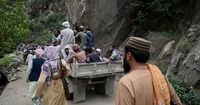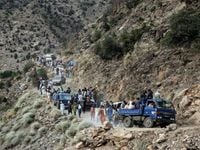In the mountainous heart of eastern Afghanistan, devastation has become a grim reality for thousands after a powerful earthquake struck on August 31, 2025. The 6.0-magnitude quake, centered in Kunar province, has left at least 2,200 people dead and transformed entire villages into fields of rubble and sorrow, according to initial United Nations assessments and Afghan authorities. But as the dust settles, a far greater challenge looms: reaching the hundreds of remote villages still cut off from aid, and ensuring survivors make it through the rapidly approaching winter.
The United Nations, which has been leading the international response, revealed this week that the true scale of the disaster may be far greater than initial assessments suggest. Shannon O’Hara, the UN humanitarian coordination chief in Afghanistan, explained during a Monday video press conference that while 49 villages have been surveyed—where 5,230 homes were destroyed and 672 more damaged—the UN has been unable to access 362 other affected communities. “Even before the earthquake, these villages were difficult to reach. Now, with the earthquake, it takes extraordinary effort to get there,” O’Hara told journalists, as reported by the Associated Press and Al Jazeera.
The numbers are staggering. Up to half a million people have been affected by the quake, with more than half of them children. Among the displaced are Afghans recently forced to return from neighboring Pakistan and Iran, adding layers of vulnerability to an already precarious situation. For many, the journey to safety has been harrowing. O’Hara described her own trek from Jalalabad, the largest nearby city, to the worst-hit area—roughly 100 kilometers away—as a 6.5-hour ordeal along a narrow, single-lane road, frequently blocked by landslides and crowded with vehicles carrying humanitarian aid. “As we drove towards the epicenter, we saw families walking in the opposite direction—displaced, carrying what little they could. Many were still wearing the same clothes from the night of the earthquake,” she said. “Mothers and fathers were carrying their children, some with fresh bandages covering their injuries.”
For the survivors, the struggle is far from over. With their homes reduced to piles of stone and mud, many now camp in fields or along riverbanks, exposed to the elements. In the village of Masud, 67-year-old farmer Adam Khan recounted, “We have no shelter, not even a tent. It rained last night, we had no place to take cover. Our biggest fear is the big rocks that could come down at any moment.” The fear of aftershocks and landslides is so intense that some survivors, like Gul Ahmad, have vowed never to return to their destroyed villages. “Even if there is no earthquake, a simple rainfall could bring rocks crashing down on us. We will not go back. The government must provide us a place,” Ahmad told Dawn.
Children, as always, are among the most vulnerable. Twelve-year-old Sadiq, who survived after being trapped for 11 hours under the rubble where his grandmother and cousin perished, described the ordeal simply: “I thought I would die. It felt like doomsday.” Families like that of farmer Shams-ur-Rahman, who lost six relatives and now sits beside the road with his family of nine and scant possessions, are left to grapple with profound grief and uncertainty. “The tents they gave us cannot even accommodate our children,” he said. “On the way down from the mountain, I had no shoes for my son, so I shared mine with him in turns as we walked down.”
Humanitarian groups have rushed in supplies by helicopter, but aid remains patchy and slow, with logistical barriers mounting by the day. Aftershocks—some as strong as magnitude 5.6—continue to rattle the region, further complicating rescue and assessment efforts. The threat of disease is also rising. With no clean drinking water or sanitation, and 92% of affected communities practicing open defecation, the risk of a cholera outbreak is “alarming,” O’Hara warned. “There was no clean drinking water and no sanitation, with cholera endemic in the region, and initial assessments indicating that 92% of these communities are practicing open defecation,” she said, highlighting the dire need for basic hygiene infrastructure.
Seasonal weather changes threaten to turn an already dire situation into catastrophe. The region is bracing for heavy rains and the onset of winter snows by the end of October, which could cut off access to mountain valleys and leave displaced families stranded. “Time is running out,” O’Hara emphasized. “At the end of October, the winter season will begin, and snow will cut off access to these mountain valleys. If we don’t act now, these communities may not survive the winter.”
The United Nations has announced plans to issue an emergency appeal for funding on September 9, 2025, to support the overwhelming needs on the ground: clean water, food, tents, latrines, and warm clothing. In visits to camps for displaced people, women in particular have stressed the need for adequate clothing and clean water for themselves and their children. “Any day, rainfall could cause flash floods in the valleys where camps for the displaced have been set up and additional aftershocks could cause more severe landslides, cutting off access to communities still living near the epicenter,” O’Hara cautioned.
Despite the immense challenges, there are glimmers of hope. The Taliban authorities have taken the lead in search and rescue operations, and, according to the UN, there has been no major obstruction to humanitarian efforts. Furthermore, the United Nations and other agencies are working to ensure that women are included in health teams and aid distribution, despite the Taliban’s restrictive policies on female employment. The World Health Organization has called on Taliban authorities to lift restrictions on Afghan female aid workers, so they can travel without male guardians and help women struggling to access care in the aftermath of the disaster.
But for now, the clock is ticking. Aid workers, survivors, and international observers agree: the coming weeks will be critical. If roads are not cleared, aid not delivered, and shelter not provided before the harsh Afghan winter sets in, the death toll could rise further—not from the quake itself, but from exposure, disease, and hunger. “If we don’t act now, these communities may not survive the coming winter,” O’Hara’s warning echoes through the valleys, a stark reminder of the urgency and scale of the crisis.
As Afghanistan faces yet another humanitarian disaster, the world watches and waits, hoping that help can reach those who need it most before time—and the weather—runs out.





